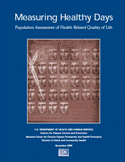Surveillance and Data
Purpose
HRQOL surveillance supports the core functions of public health—assessment, policy development and assurance. With respect to an assessment, HRQOL surveillance is used to identify unmet population health needs including recognizing trends, disparities, and determinants of health in the population. With respect to policy development, HRQOL surveillance data can be used to inform decision making and program development. With respect to assurance, HRQOL surveillance data can be used for program evaluation to assure that the population is benefiting from public health programs. A compact set of HRQOL measures, including a summary measure of unhealthy days, has been developed and validated for population health surveillance and has been widely used since 1993.
Data Sources
The CDC Healthy Days measures are an acknowledged standard for population health surveillance by national and international groups.
- The Healthy Days questions have been asked of all participants in the Behavioral Risk Factor Surveillance System (BRFSS) from 1993 through 2015 (except in 2002 when only 20 states asked these questions).
- From 2000 to 2012, the Healthy Days measures have also been administered to respondents aged 12 years or older in the National Health and Nutrition Examination Survey (NHANES).
- The Healthy Days questions have been included on the Medicare Health Outcomes Survey (HOS) of Medicare Advantage beneficiaries since 2003. The National Committee for Quality Assurance has adopted the HOS as a component of HEDIS (Health Plan Employer Data and Information Set), the most widely used set of performance measures in the managed care industry.
These measures also have been used in other countries including Canada, Sweden, and Italy. The Healthy Days data from the BRFSS are regularly included in several national, state, and community “health report cards.”
HRQOL Surveillance Data available for local, county, state, or national estimates
Go to the PLACES Data Portal to view, search, filter, and download HRQOL (mental health and physical health) data by county, place (incorporated and census designated place), census tract, or ZIP Code Tabulation Area (ZCTA) to create a custom report, customize visualizations, and more.
Explore the University of Wisconsin Population Health Institute’s County Health Rankings to learn how CDC Healthy Days are used with other county health indicators and to see how the average number of physically and mentally unhealthy days were reported in your county.
Visit the United Health Foundation’s America’s Health Rankings data for trends in frequent mental distress in the United States overall (2011–2019) and by subgroups using the CDC mentally unhealthy days indicator.
What are the main advantages of the Healthy Days measures and population data?
- Reflect known demographic and socioeconomic disparities and health patterns.
- Reflect the burden of physical and mental illness and disability.
- Are validated against other established measures (e.g., MOS Short Form 36).
- Predict short-term mortality, hospitalizations, and physician visits.
- Provide new insights into health behaviors.
- Indicate important new policy-relevant disparities and trends.
- Provide a focus for comprehensive community health programs.
- Provide comparable population data from 1993 onward.
- Are simple to measure, calculate, interpret, and add to other assessments.
The Healthy Days measures and accumulating population data offer considerable promise as part of a public health paradigm that looks at health as a broad multidimensional construct, comprising both physical and mental well-being.
